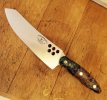Those steels you mentioned, Warren, excel in edge stability, provided they are heat treated correctly, of course. Throw in the O-7 series (1.2442 and 1.2519) as well. As long as corrosion resistance is not the biggest concern, these steels behave very well at high hardness levels (62HRC+) and low edge angles (< 15° per side). Wear resistance has limited application in the kitchen, and none of these steels have high wear resistance...so they're easy to re-sharpen to a very keen edge. I never even cared for the idea of S35VN as a kitchen knife steel, personally. If corrosion resistance is a concern for the user, AEB-L would be my pick, due to it's ease of sharpening over S35VN, and can take a sharper edge more efficiently. These kitchen knife steels should be tempered hard, and with thin geometry, and low edge angles. I know you get that, Warren. Not preaching at you, more to the point...WITH you!
"I was told the higher chromium steels had too course grain to be acceptable for kitchen knives." Definitely not necessarily the case. AEB-L has over twice the Cr of A2, and we all know how fine the grain in that steel can be! If it's a kitchen knife that might see protein slicing duty quite heavily, I bet even D2 would work very well (probably best with the cutlery grade HT instead of industry standard HT). D2 and AEB-L have roughly the same Cr %, but the much higher Carbon % in D2 causes those large clunky carbides, while the relatively low Carbon % in AEB-L allows for the very small Cr carbides. You might even experiment with "pre-quench" on A2 for kitchen knives. Not the same as double quench, but pre-quenching (from what I gather) puts some carbon in solution up front allowing for lower hardening temp/shorter soak time. Thus smaller aus grain. Sub Zero "should" be used with A2, as well, due to higher RA levels, if not full on cryo temps. Speaking of Chromium in kitchen knife steels, here is a pic of my latest kitchen knife, a Tosogata inspired Santoku with Aldo's 52100 at 65HRC (normalized 1700F, 3x cycles, 1475F 10 minute soak, P50, 300F 2hours 3x). Edge was taken to "zero" with the full flat grind, and then sanded back just enough to reflect light and allow some meat for the edge. Took about 5 minutes to sharpen with the 1200 mesh DiaSharp, then refined with the EEF DiaSharp, 15° per side. It is incredibly sharp! For sale in the exchange if interested.
Thank you all for your pictures in this thread! Awesome kitchen knives, guys!
 IMG_5604 by Robert Erickson, on Flickr
IMG_5604 by Robert Erickson, on Flickr IMG_5606 by Robert Erickson, on Flickr
IMG_5606 by Robert Erickson, on Flickr










